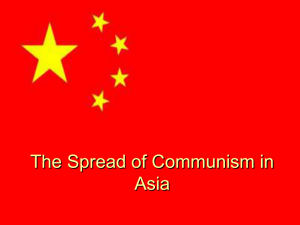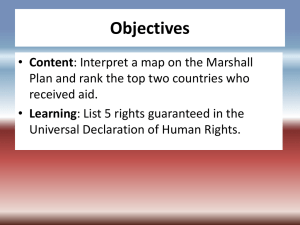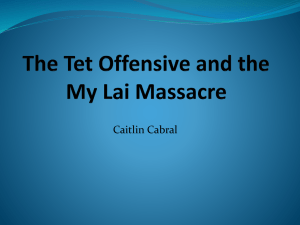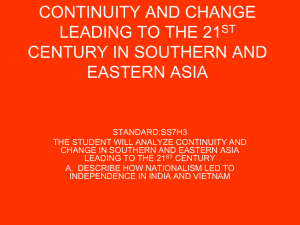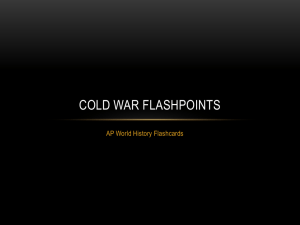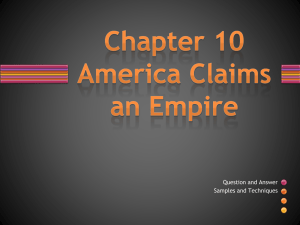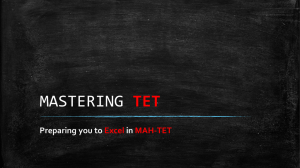Standard 20 Powerpoint with questions
advertisement
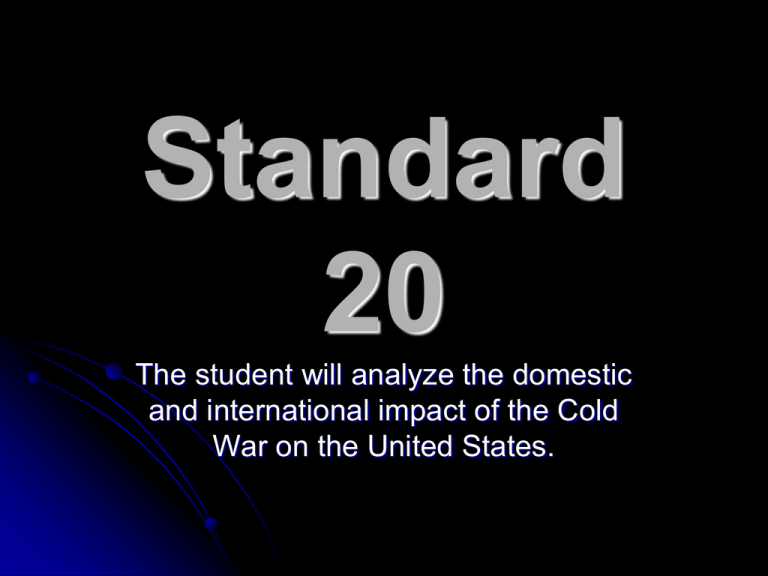
Standard 20 The student will analyze the domestic and international impact of the Cold War on the United States. A The Marshall Plan The Marshall Plan was developed to help rebuild Europe after the war. It was also known as the European Recovery Program. Another goal of it was to save Europe from Communism. The Marshall Plan gave economic aid to any nation that promises to resist Communism and remain committed to democracy. WW II signals the end of the U.S. as a country that supports neutrality as a foreign policy. Containment Containment is the military strategy for the western powers, developed by George Kennan The goal is to contain Communism and not let it spread The overriding goal of American policy of the 1950’s was to stop Communism from spreading This is why we go to war in Korea during the 50’s. The Truman Doctrine Truman called on the US to take a leadership role in the affairs of the world. He wanted the US to work to prevent the spread of Communism by supporting weaker nations. The policy of containment was introduced as America’s foreign policy with the A. B. C. D. The Tet Offensive The Truman Doctrine The Berlin Airlift The Marshall Plan The Truman Doctrine stated that A. B. C. D. The US would not tolerate Communists in high levels of US government. The US would not hesitate to intervene to help foreign nations resist communism. The US would not cross the 38th parallel during the Korean War. The US would support Mao’s revolution in China. Which of the following was meant to rebuild parts of Europe suffering economic hardship in an effort to prevent the spread of communism? A. B. C. D. The Marshall Plan Containment policy Cold warfare The space race B China Goes Communist Led by Mao Zedong, the communists took control of China in 1949. Mao led China through the Great Leap Forward during the late 1950s and early 1960s. An attempted movement to move China from a farming country to an industrialized nation. It failed horribly. It destroyed the educational and economic systems of China. Millions of Chinese starved to death during the Great Leap Forward. The Korean War In June 1950, the Korean War broke out when North Korean troops crossed the 38th parallel into South Korea. In July 1953, a truce, not a peace treaty, was signed and divided Korea at almost the exact place as before the war, the 38th parallel. The McCarthy Era Republican senator Joseph McCarthy of Wisconsin claimed in 1950 he knew of 205 communists in the government. This started the red scare of the 1950s. When he accused the army of protecting communists, the government ended his career. What was the focus of McCarthyism? A. B. C. D. A presidential bid Campaign finance reform A political movement promoting liberalism Rooting out communism in the United States Mao Tse-tung concerned leaders in the US because he was A. B. C. D. A militaristic leader who led Japan down an aggressive path. The communist leader of North Vietnam who was intent on conquering the South. A communist leader who allowed the USSR to place missiles ninety miles off the coast of Florida. A communist revolutionary who ultimately took over China. What did the Communist takeover in China and the Korean War give rise to in America? A. B. C. D. The space age Communism McCarthyism The Marshall Plan A supporter of Joseph McCarthy would have been most disturbed by A. B. C. D. The actions of HUAC. McArthur’s actions in Korea. The idea of Communists in the US government. The failure of North Korea to successfully defeat South Korea. C Cuban Revolution In 1958, Fidel Castro took over Cuba. The US refused to help because the CIA said the revolution was full of communists. The US cut ties with Cuba after Castro confiscated US property in Cuba. Cuba was then forced to turn to the Soviet Union for assistance. The Bay of Pigs An unsuccessful April 17, 1961 United States CIA-backed invasion of Cuba. The US was attempting to overthrow Fidel Castro’s communist government. It greatly damaged the American image around the world. The Cuban Missile Crisis In 1962, Russia began placing nuclear weapons in Cuba. The US demanded that these weapons be removed from Cuba. The nuclear missiles given to Cuba could have easily reached Washington D.C. and the entire eastern seaboard. The US established a naval blockade around Cuba to prevent the weapons from entering Cuba. Russian ships turned around before confronting the blockade and prevented an escalation of the crisis. It is the moment when the Cold War came closest to a nuclear war. What prompted the Cuban Missile Crisis? A. B. C. D. The Tet Offensive The Cuban Revolution The discovery of Soviet missiles in Cuba The interest in overthrowing Fidel Castro The Cuban Revolution concerned US presidents because A. B. C. D. Castro had nuclear weapons and vowed to use them against Florida. Cuba was even more afraid of communism that the US and wanted to start a war against the USSR. The new Cuban government attempted to invade Mexico at the Bay of Pigs. It established a communist government just 90 miles from the United States. D The Vietnam War Ho Chi Minh was the leader of communist North Vietnam. The US supported the democratic South Vietnam. The US fought to prevent the spread of communism into South Vietnam. The Tet Offensive It was an attack by the North Vietnamese against the South Vietnamese and the US that started on the Vietnamese holiday of Tet. Although the attack was not effective for the North Vietnamese, it did have a profound impact on the American public. The American public had been told that the US was winning the war and that the North Vietnamese were unable to do something of this magnitude. The Tet Offensive lead to the growth of American opposition to the Vietnam War at home. Opposition to the War American military commanders had told the public that all they needed was a “real battle” and they could defeat the Viet Cong The Tet Offensive provided that battle and the Communists acquitted themselves well against the power of the US This contradicted the military and led the American public to question their government and their military Protest was significant following the Tet Offensive and the people started to call for US withdrawal These shocking photos also helped change public opinion about the war. Here is How to Protest The decline in public support for the Vietnam War included all of the following EXCEPT A. B. C. D. Scenes of the carnage shown on television The space race The death of American soldiers Protests calling for an end to the war Which of the following countries was a US ally during the Cold War? A. B. C. D. Great Britain North Vietnam East Germany Cuba What effect did the Tet Offensive have? A. B. C. D. It convinced Congress to pass the GI Bill. It increased opposition to the Vietnam War in the United States. It united most of the country behind Lyndon Johnson’s war strategy. It convinced the US to enter the space race. Essay Questions 1. 2. How does the media play a roll in the public’s view of world events and wars? Explain the similarities and differences with the Vietnam War and the War in Iraq. This is due today. Each answer must be a least 8 sentences long.


